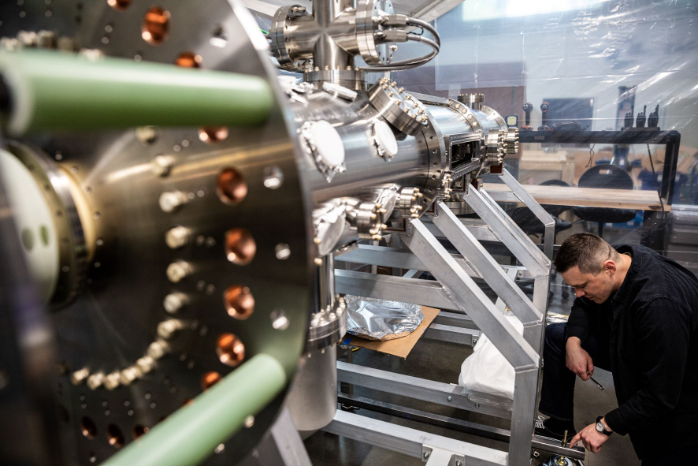
ARPA-E Investor Update Vol. 2: Zap Energy's Z-Pinch Fusion Prototype
Update: July 2022
After raising $27.5 million in their Series B fundraising round in May 2021, Zap Energy recently announced they raised an additional $160 million in follow-on funding. Lowercarbon Capital led their Series C funding round, with additional investors including Breakthrough Energy Ventures, Shell Ventures, DCVC, and Valor Equity Partners. The Zap Energy team also announced a major technical milestone last month. Zap Energy created the first plasma in their FuZE-Q prototype. With the roughly $200 million in additional funding Zap has secured since 2017 and the first plasma created in their FuZE-Q, the team is making progress toward the conditions needed for scientific energy breakeven and beyond.

Zap Energy’s FuZE-Q. Photo Credit of Zap Energy: https://www.zapenergyinc.com/news/first-plasmas-fuzeq-series-c
On August 12, 2020, Chevron Corporation announced their involvement in fusion-energy startup Zap Energy’s Series A fundraising round, through Chevron’s venture capital fund Chevron Technology Ventures (CTV). The investment was CTV’s 10th since its launch in 2018 and placed the total amount of Zap’s Series A fundraising round at $6.5M.[1] In the announcement, CTV highlighted their part in Zap’s Series A as an “…opportunity to enhance the company’s focus on a diverse portfolio of low-carbon energy resources with the capacity to provide communities across the globe access to affordable, reliable, and ever-cleaner energy.”[2]
Zap Energy was founded in 2017 as a spinout from the FuZE (Fusion Z-pinch Experiment) research team at the University of Washington. Prior to spinning out, the FuZE team received funding from several U.S. Department of Energy programs, dating back to 1998. While the FuZE team had been working on the science of plasma stabilization of their fusion concept for decades, ARPA-E began supporting the FuZE team in 2015 on advancing the fusion performance of their concept, as part of the Accelerating Low-Cost Plasma Heating and Assembly (ALPHA) program. This would later lead to the founding of Zap Energy.
ALPHA was ARPA-E’s first focused program in fusion energy. The main goal of ALPHA was to create and demonstrate tools to aid in the development of new, lower-cost pathways to fusion power, and to enable more rapid progress in fusion research and development. Through ALPHA, the University of Washington received $6M in funding to advance the performance of the sheared-flow-stabilized (SFS) Z-Pinch approach for simultaneously heating, confining, and compressing plasma by applying an intense, pulsed electrical current that generates a magnetic field. Their design simplifies the engineering required for a fusion system through a reduced number of components and increased efficiency, thus enabling research to progress faster through lower costs and more rapid experimentation.[3]
The FuZE team at the University of Washington was one of the most successful performers in ALPHA, and in 2017 spun out to create a new private fusion startup Zap Energy.[4] In 2018, Zap was selected to further develop their SFS Z-Pinch concept, receiving $6.7M in funding under ARPA-E’s OPEN 2018 program, which was ARPA-E’s fourth OPEN funding opportunity designed to catalyze transformational breakthroughs across the entire spectrum of energy technologies. Zap was chosen to further advance the performance of their SFS Z-pinch fusion concept by raising the electrical current of their SFS Z-pinch. This would reduce physics risks relating to plasma stability and confinement, and identify needed improvements in electrode technology and plasma-initiation techniques to advance toward energy breakeven.[5] During ALPHA and OPEN 2018, the FuZE/Zap team demonstrated a remarkable factor of 50 increase in 3–4 years in the key scientific metric of the fusion triple product,[6] though there is still a ways to go to reach energy breakeven.
In April 2020, ARPA-E announced selections under its second focused fusion-energy program, Breakthroughs Enabling THermonuclear-fusion Energy (BETHE). BETHE teams are working to develop timely, commercially viable fusion energy, with the goal to increase the number and performance levels of lower-cost fusion concepts. Through BETHE, Zap was selected again by ARPA-E to receive $1M in funding to incorporate more flexibility in their SFS Z-Pinch experiments for advancing toward energy breakeven.[7]
Zap Energy’s trajectory is a great example of how technology innovation and tech-to-market works at ARPA-E. By first working with a university research team to develop a successful and innovative concept, then helping it spin out to a startup company by further funding the development of their technology, and assisting them in gaining attention from the private sector, this ARPA-E funded team is now working with one of the world’s largest energy companies to develop their technology even further. Additionally, the investment by CTV into a fusion-energy company makes the case for how the commercial energy market and major energy companies are evolving to view fusion energy as a potentially viable future energy-generation resource.
For more on ARPA-E’s OPEN 2018 program, click HERE, and for more on ARPA-E’s fusion energy programs, click here: ALPHA, BETHE, GAMOW. Stay tuned for more exciting Investor Updates as we continue to track what some of the most successful ARPA-E performers have gone on to achieve since working with ARPA-E!
[1] https://www.reuters.com/article/us-chevron-investment-nuclear/oil-major-chevron-invests-in-nuclear-fusion-startup-zap-energy-idUSKCN25831E
[2] https://www.businesswire.com/news/home/20200812005676/en/Chevron-Invests-in-Nuclear-Fusion-Start-up
[5] https://arpa-e.energy.gov/technologies/projects/electrode-technology-development-sheared-flow-z-pinch-fusion-reactor
